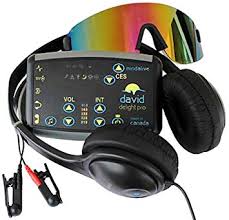Audio-Visual Entrainment (AVE) is a technique that utilizes the process of entrainment via pulses of light and sound at specific frequencies. Entrainment occurs when an EEG reflects the brain wave frequency duplicating that of the stimuli, be it audio, visual or tactile. The objective of entrainment is to produce a dissociative, meditation-like state – it’s essentially a safe way of putting oneself into deep relaxation. When we are able to enter into a state of dissociation, we get drawn into the present moment and disconnect from all of our daily hassles, worries, anxieties and the resulting unhealthy mental chatter. Regardless of the activity or our awareness of the act, this type of dissociation reduces our overall stress load. This allows for rehabilitation of the mind and body, beneficial neurotransmitters to be released into the brain for mood stabilization and optimal brain function, and encourages the release of the body’s regenerative and repair chemicals (parasympathetic hormones). When in this frame of being, the body is also able to tap into deep diaphragmatic breathing which gives increased perfusion to the brain and extremities.

AVE is a non-invasive approach to gently guide the brain into various brain wave patterns, which allows for the ability to boost mood, improve sleep, sharpen mind, increase relaxation, and improve academic and cognitive performance. It’s proven to be an effective therapy for Attention Deficit Disorder (ADD), anxiety disorders, Seasonal Affective Disorder (SAD), PTSD, Fibromyalgia, and, in some cases, chronic pain. Additionally, utilizing the AVE not only increases blood flow to the brain, but also increases the metabolization of glucose in the brain allowing for improved function of neurons. The combination of these two metabolic processes leads to general improved mental performance.
To determine if you are a candidate for AVE, and your unique protocol, we recommend that a QEEG be done first. You can read more about QEEG’s by Clicking Here . For AVE training sessions, much of which can be done at home, our modality of choice is the DAVID Delight.
DAVID Delight Pro
The DAVID Delight Pro provides audio-visual entrainment sessions and cranio-electro stimulation (CES). Based on the most current research findings, sessions on the DAVID Delight ensure the most effective results, no matter your reason for use. Sessions also include a proprietary randomization process, which helps encourage dissociation and brain frequency tracking to the stimulus. It features 25 sessions which are organized into five distinct categories to suit individual’s needs: Energize, Meditate, Brain Brightener, Sleep and Mood Booster, with five selections for each category.
There are a number of things that are going on when you are using a DAVID :
1) Your EEG activity is being altered – As the AVE frequency changes, so does the frequency in the brain – it’s that easy! For example, our Feeling Better sessions re-stabilize brainwaves by suppressing left frontal alpha while boosting right frontal alpha to normal levels.
2) You are being dissociated – When using AVE, you get drawn into the present moment and let go of thoughts relating to your daily hassles, hectic schedules, paying bills, worries, threats or anxieties and stop the unhealthy mental “chatter.” Dissociation involves a “disconnection” of self from thoughts and body awareness, as is experienced during deep meditation. Dissociation begins in four to eight minutes from properly applied AVE.
3) Your limbic system is being stabilized – Your body is calmed, your breathing becomes rhythmic, your hands warm and your muscles relax.
4) A number of neurotransmitters are being produced – People with depressed mood have low levels of serotonin and norepinephrine. AVE boosts brain levels of serotonin, and norepinephrine to improve overall well-being.
5) Your cerebral blood flow is being increased – CBF is associated with many forms of mental disorders, including anxiety, depression, attentional problems, behavior disorders and impaired cognitive function. CBF tends to lower as we age often causing cognitive decline. People experiencing depressed mood usually have lower levels of CBF in the left frontal and prefrontal lobes.
